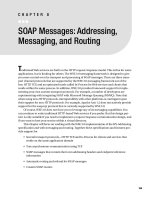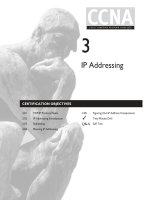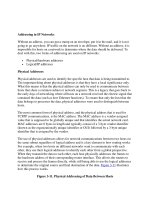Addressing subneting
Bạn đang xem bản rút gọn của tài liệu. Xem và tải ngay bản đầy đủ của tài liệu tại đây (2.19 MB, 78 trang )
Addressing & Subnetting
for Exploration-S1
1
PDF created with pdfFactory trial version www.pdffactory.com
Addressing
• …to identify and locate each host. We call it
•
•
“addressing”.
Identification: hostname, address (MAC, IP)
– IP address ? MAC add ?
• MAC address: local
• IP address: internetwork
An address generally represents the connection to
the network
2
PDF created with pdfFactory trial version www.pdffactory.com
Addressing
unique address: letter (network address) and number (host address)
3
PDF created with pdfFactory trial version www.pdffactory.com
IP Address (IPv4)
• IP address is 32-bit long.
• It is often writen in dotted decimal format.
4
PDF created with pdfFactory trial version www.pdffactory.com
IP Addressing Structure
•
•
•
•
•
•
IP add has 2 parts: net-id & host-id
Two different networks must have different network
address (net-id).
2 different hosts in the same network must have different
host address (host-id).
Hosts in the same network have the same network
address.
Broadcast domain: one network address
Network address= IP address AND Subnet mask
5
PDF created with pdfFactory trial version www.pdffactory.com
IP Addressing Structure
•
32-bit address
is expressed in
Dotted decimal
•
Network portion
•
Host portion
•
Octet
6
PDF created with pdfFactory trial version www.pdffactory.com
Subnet Mask
•
•
•
The subnet mask is 32-bit pattern and created by
– placing a binary 1 in each bit position that represents the network
portion and
– placing a binary 0 in each bit position that represents the host
portion.
The prefix and the subnet mask are different ways of representing the
same thing - the network portion of an address.
– The number of bits of an address used as the network portion is
called the prefix length.
In 8-bit pattern, there are:
00000000 = 0
11110000 = 240
10000000 = 128
11111000 = 248
11000000 = 192
11111100 = 252
11100000 = 224
11111110 = 254
11111111 = 255
7
PDF created with pdfFactory trial version www.pdffactory.com
Defining the Network and Host Portions
8
PDF created with pdfFactory trial version www.pdffactory.com
Defining the Network and Host Portions
9
PDF created with pdfFactory trial version www.pdffactory.com
Example 1:
SM
: 255.255.255.0
Net/host id: N.N.N.H
Net E1 (Net-ID): 192.168.11.0
Net E2
: 192.168.10.0
Net E3
: 192.168.12.0
Number of broadcast domain ?
10
PDF created with pdfFactory trial version www.pdffactory.com
Example 2:
SM: 255.255.255.0
Net address: 192.168.10.0
Net/host id: N.N.N.H
H: hhhhhhhh
00000000
00000001
00000010
00000011
00000100
…
11111110
11111111
11
PDF created with pdfFactory trial version www.pdffactory.com
Example 3:
•
•
•
•
IP address: 192.168.100.1
Subnet mask: 255.255.255.0
Net address: 192.168.100.0
Net/Host ID: N.N.N.H
•
•
•
IP address : 11000000.10101000.01100100.00000001
SM
: 11111111.11111111.11111111.00000000
Net address : 11000000.10101000.01100100.00000000
12
PDF created with pdfFactory trial version www.pdffactory.com
Example 4:
•
•
•
IP address: 96.168.100.1
Subnet mask: 255.255.224.0
Net address: ?
•
•
•
IP address : 01100000.10101000.01100100.00000001
SM
: 11111111.11111111.11100000.00000000
Net address : 01100000.10101000.01100000.00000000
13
PDF created with pdfFactory trial version www.pdffactory.com
Hierachical addressing scheme
As a hierachical addressing scheme, IP addresses are divided into
“classes”.
14
PDF created with pdfFactory trial version www.pdffactory.com
Classes of IP Addresses
•
•
•
Class A addresses are
assigned to larger
networks.
Class B addresses are
used for medium-sized
networks
Class C for small
networks.
15
PDF created with pdfFactory trial version www.pdffactory.com
Classes of IP Addresses
•
•
First octet order bits:
– Class A: 00000000
00000001
…
01111110
01111111
First octet order bits:
– Class C: 11000000
11000001
…
11011110
11011111
(0)
(1)
•
(126)
(127)
•
(192)
(193)
(222)
(223)
First octet order bits:
– Class B: 10000000
10000001
…
10111110
10111111
First octet order bits:
– Class D: 11100000
11100001
…
11101110
11101111
(128)
(129)
(190)
(191)
(224)
(225)
(238)
(239)
16
PDF created with pdfFactory trial version www.pdffactory.com
Classes of IP Addresses
17
PDF created with pdfFactory trial version www.pdffactory.com
Type of Address in an IPv4 Network
•
Three types of addresses:
– Network address - The address by which we refer
to the network. All hosts in a network will have the
same network bits.
– Broadcast address - A special address used to
send data to all hosts in the network. The broadcast
address uses the highest address in the network
range. This is the address in which the bits in the
host portion are all 1s. This address is also referred
to as the directed broadcast.
– Host addresses - The addresses assigned to the
end devices in the network
18
PDF created with pdfFactory trial version www.pdffactory.com
Network Address
•
When all host-bits are zeros (0), we have a number that represents network
address. This address is reserved, namely it cannot be assigned to any host.
19
PDF created with pdfFactory trial version www.pdffactory.com
Network Address
20
PDF created with pdfFactory trial version www.pdffactory.com
Broadcast Address
•
•
When host-bits are all one (1), we have a number that represents broadcast
address. This address is also reserved, namely it cannot be assigned to any host.
Exp:
– ping 10.0.6.255
– Ping 255.255.255.255
21
PDF created with pdfFactory trial version www.pdffactory.com
Broadcast Address
22
PDF created with pdfFactory trial version www.pdffactory.com
Extra: Broadcast Address
•
The router supports the following kinds of broadcast types:
– Limited broadcast - A packet is sent to a specific network or series of
networks. In a limited broadcast packet destined for a local network, the
network identifier portion and host identifier portion of the destination
address is either all 1s (255.255.255.255) or all 0s (0.0.0.0).
– Directed broadcast - A packet is sent to a specific destination address
where only the host portion of the IP address is either all 1s or all 0s (such
as 192.20.255.255 or 190.20.0.0).
23
PDF created with pdfFactory trial version www.pdffactory.com
Host address
24
PDF created with pdfFactory trial version www.pdffactory.com
25
PDF created with pdfFactory trial version www.pdffactory.com









